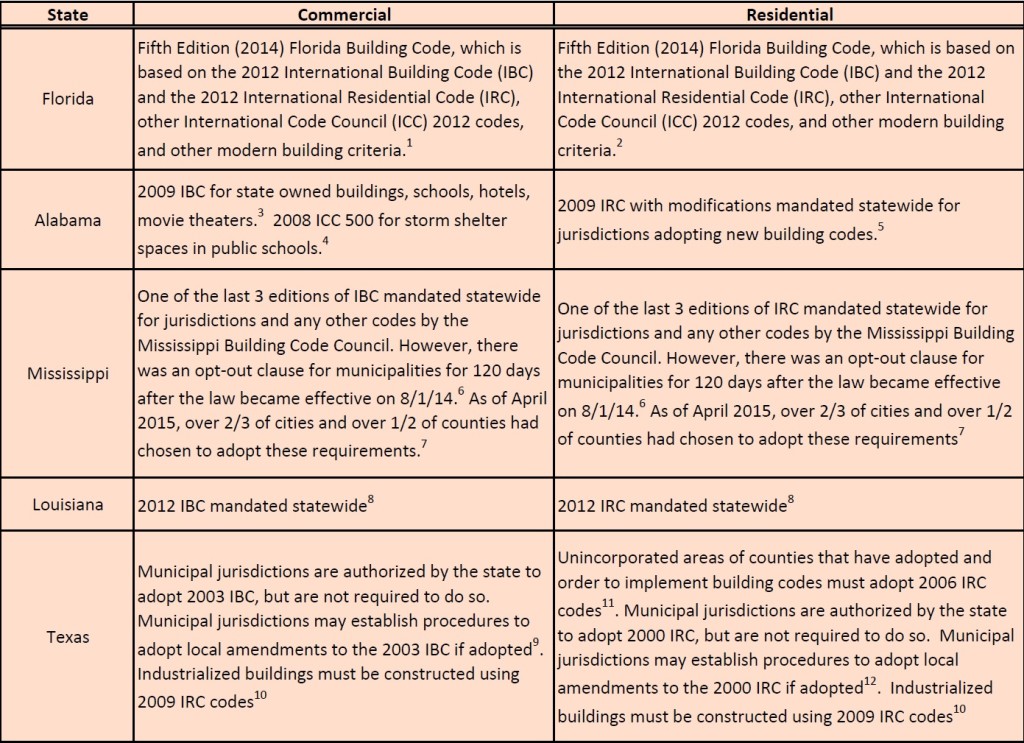States
Where states have adopted building codes, they are based on one of the standard codes, usually the International Building Code (IBC) for commercial and multifamily structures, and the International Residential Code (IRC) for single and two-family structures. The latest version of these codes is 2015 (International Code Council), with wind and flood provisions also updated to 2015.
Only Florida, and recently Louisiana, mandate state codes for both residential and commercial buildings for all municipalities, with specific requirements for counties or parishes on the coast and in high wind hazard areas. (See Table 4 above.) Florida’s code is managed by the Florida Building Commission, part of the Department of Community Affairs, the same department that manages flood issues and community planning. The building code appears to be enforced primarily at the city and county level. The recently passed Louisiana Building Code is administered and enforced statewide by the Uniform Construction Code Council (UCCC), and implemented through municipal and parish building inspectors.
Alabama mandates statewide residential code enforcement, but only enforces commercial building codes for certain state owned and high occupancy buildings. Mississippi recently mandated statewide residential and commercial building code enforcement, but allowed for municipalities and counties to opt-out of this code enforcement. As of April 2015, over 2/3 of municipalities and over 1/2 of counties in Mississippi had adopted statewide building codes. Texas does not mandate a statewide state building code for either residential or commercial structures, but it does recommend adoption of the 2003 IBC and 2000 IRC for municipalities and counties. In unincorporated areas of counties where a county wishes it adopt building codes, Texas mandates use the 2006 IRC for new or modified residential construction. Additionally, all industrialized buildings in Texas must be constructed with 2009 IBC and IRC code specifications.
Insurance Institute for Business & Home Safety (IBHS) Rating the States: 2015 Report
Again, Florida and Louisiana ranked highly as a result of their solid statewide building codes and assessment process for building professionals and construction firms. Mississippi saw marked improvement from its last-place rank in the 2012 IBHS report after it passed a statewide building code law. However, Mississippi, Texas, and Alabama still scored close to the bottom of the 18 states assessed by the 2015 report, only surpassing Delaware. However, it should be noted that these three states did improve upon their 2012 score, indicating advances were occurring in coastal resiliency.
Local
Though lacking full statewide mandates in three gulf coast states, cities and counties are free to adopt their own building codes. There has been a flurry of activity, in fact, as cities in the Katrina impact zone have updated their building codes. In Mississippi, Biloxi, Gulfport, and Pass Christian, for example, now all list the 2012 IBC and IRC as their official building codes, with some amendments . The Mississippi Legislature passed House Bill 1406 in 2006 requiring stricter building codes for the coastal counties of Hancock, Harrison, Jackson, Pearl River, and Stone. However, the counties and municipalities in Mississippi that choose to opt-out of the 2014 statewide code mandate, may still not have updated codes.
In Texas, the coastal city of Rockport mandates the 2012 IBC and IRC, but adjacent Fulton appears to have no building code, and the county they are both located in, Aransas County, also appears to have no specific building code. The Texas Windstorm Insurance Association (TWIA) does require inspections for both commercial and residential structures to be eligible for windstorm (hurricane) insurance, and insured structures, when located in specific wind hazard zones outlined by the TWIA, must be built to withstand wind loads using the 2006 IBC and IRC.
Examples of resilient strategies incorporated in the Dade County South Florida Building Code
From: Residential Wind Damage in Mississippi Potential Hurricane Damage Reduction Through Improved Building Codes and Construction Practices. January 19, 2006. LSU Hurricane Center
Protection of Building Openings
Windows and doors are the weak spots in the wall envelope. Requiring debris impact resistant windows and doors or debris impact protective coverings (shutters) prevents most window and door failures. This helps keep the wind and rain out of the building, reducing structural damage, damage to finishes, and damage to contents.
Improved Roof Sheathing Attachment
Better attachment of the plywood or OSB roof sheathing to the roof structure through appropriate fasteners and closer fastener spacing helps prevent sections of the roof deck from being lifted off by the wind. This reduces
progressive failures and wind and water from penetrating the building envelope.
Improved Roof-Wall Connections
Installation of metal ‘hurricane clips’ or ‘hurricane straps’ provides a continuous loadpath from the roof to the foundation, helping prevent catastrophic roof uplift failures.




